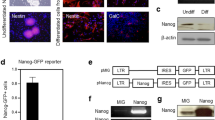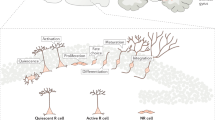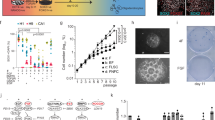Abstract
Adult mammalian neurogenesis occurs in the hippocampus and the olfactory bulb, whereas neocortical adult neurogenesis remains controversial. Several occurrences of neocortical adult neurogenesis in injured neocortex were recently reported, suggesting that neural stem cells (NSCs) or neuronal progenitor cells (NPCs) that can be activated by injury are maintained in the adult brain. However, it is not clear whether or where neocortical NSCs/NPCs exist in the brain. We found NPCs in the neocortical layer 1 of adult rats and observed that their proliferation was highly activated by global forebrain ischemia. Using retrovirus-mediated labeling of layer 1 proliferating cells with membrane-targeted green fluorescent protein, we found that the newly generated neurons were GABAergic and that the neurons were functionally integrated into the neuronal circuitry. Our results suggest that layer 1 NPCs are a source of adult neurogenesis under ischemic conditions.
This is a preview of subscription content, access via your institution
Access options
Subscribe to this journal
Receive 12 print issues and online access
$209.00 per year
only $17.42 per issue
Buy this article
- Purchase on Springer Link
- Instant access to full article PDF
Prices may be subject to local taxes which are calculated during checkout







Similar content being viewed by others
References
Gross, C.G. Neurogenesis in the adult brain: death of a dogma. Nat. Rev. Neurosci. 1, 67–73 (2000).
Ming, G.L. & Song, H. Adult neurogenesis in the mammalian central nervous system. Annu. Rev. Neurosci. 28, 223–250 (2005).
Gage, F.H. Mammalian neural stem cell. Science 287, 1433–1438 (2000).
Abrous, D.N., Koehl, M. & Le Moal, M. Adult neurogenesis: from precursors to network and physiology. Physiol. Rev. 85, 523–569 (2005).
Altman, J. Autoradiographic investigation of cell proliferation in the brains of rats and cats. Anat. Rec. 145, 573–591 (1963).
Kaplan, M.S. Neurogenesis in the 3-month-old rat visual cortex. J. Comp. Neurol. 195, 323–338 (1981).
Gould, E., Reeves, A.J., Graziano, M.S.A. & Gross, C.G. Neurogenesis in the neocortex of adult primates. Science 286, 548–552 (1999).
Kornack, D.R. & Rakic, P. Cell proliferation without neurogenesis in adult primate neocortex. Science 294, 2127–2130 (2001).
Bernier, P.J., Bédard, A., Vinet, J., Lévesque, M. & Parent, A. Newly generated neurons in the amygdale and adjoining cortex of adult primates. Proc. Natl. Acad. Sci. USA 99, 11464–11469 (2002).
Koketsu, D., Mikami, A., Miyamoto, Y. & Hisatsune, T. Nonrenewal of neurons in the cerebral neocortex of adult macaque monkeys. J. Neurosci. 23, 937–942 (2003).
Ehninger, D. & Kempermann, G. Regional effects of wheel running and environmental enrichment on cell genesis and migration proliferation in the adult murine neocortex. Cereb. Cortex 13, 845–851 (2003).
Dayer, A.G., Cleaver, K.M., Abouantoun, T. & Cameron, H.A. New GABAergic interneurons in the adult neocortex and striatum are generated from different precursors. J. Cell Biol. 168, 415–427 (2005).
Spalding, K.L., Bhardwaj, R.D., Buchholz, B.A., Druid, H. & Frisén, J. Retrospective birth dating of cells in humans. Cell 122, 133–143 (2005).
Gu, W., Brännström, T. & Wester, P. Cortical neurogenesis in adult rats after reversible photothrombotic stroke. J. Cereb. Blood Flow Metab. 20, 1166–1173 (2000).
Magavi, S.S., Leavitt, B.R. & Macklis, J.D. Induction of neurogenesis in the neocortex of adult mice. Nature 405, 951–955 (2000).
Jiang, W. et al. Cortical neurogenesis in adult rats after transient middle cerebral artery occlusion. Stroke 32, 1201–1207 (2001).
Jin, K. et al. Directed migration of neuronal precursors into the ischemic cerebral cortex and striatum. Mol. Cell. Neurosci. 24, 171–189 (2003).
Sundholm-Peters, N.L. et al. Subventricular zone neuroblasts emigrate toward cortical lesions. J. Neuropathol. Exp. Neurol. 64, 1089–1100 (2005).
Tonchev, A.B., Yamashima, T., Sawamoto, K. & Okano, H. Enhanced proliferation of progenitor cells in the subventricular zone and limited neuronal production in the striatum and neocortex of adult macaque monkeys after global cerebral ischemia. J. Neurosci. Res. 81, 776–788 (2005).
Jin, K. et al. Evidence for stroke-induced neurogenesis in the human brain. Proc. Natl. Acad. Sci. USA 103, 13198–13202 (2006).
Leker, R.R. et al. Long-lasting regeneration after ischemia in the cerebral cortex. Stroke 38, 153–161 (2007).
Yang, Z. et al. Sustained neocortical neurogenesis after neonatal hypoxic/ischemic injury. Ann. Neurol. 61, 199–208 (2007).
Stewart, R.R., Hogo, G.J., Zigova, T. & Luskin, M.B. Neural progenitor cells of the neonatal rat anterior subventricular zone express functional GABAA receptors. J. Neurobiol. 50, 305–322 (2002).
Tozuka, Y., Fukuda, S., Namba, T., Seki, T. & Hisatsune, T. GABAergic excitation promotes neuronal differentiation in adult hippocampal progenitor cells. Neuron 47, 803–815 (2005).
Cobos, I., Long, J.E., Thwin, M.T. & Rubenstein, J.L. Cellular patterns of transcription factor expression in developing cortical interneurons. Cereb. Cortex 16, i82–i88 (2006).
Flames, N. et al. Delineation of multiple subpallial domains by the combinatorial expression of transcriptional codes. J. Neurosci. 27, 9682–9695 (2007).
Kameda, H. et al. Targeting green fluorescent protein to dendritic membrane in central neurons. Neurosci. Res. 61, 79–91 (2008).
Kress, G.J. & Mennerick, S. Action potential initiation and propagation: upstream influences on neurotransmission. Neuroscience 158, 211–222 (2009).
Hioki, H. et al. Efficient gene transduction of neurons by lentivirus with enhanced neuron-specific promoters. Gene Ther. 14, 872–882 (2007).
Nunes, M.C. et al. Identification and isolation of multipotential neural progenitor cells from the subcortical white matter of the adult human brain. Nat. Med. 9, 439–447 (2003).
Kubota, Y., Hattori, R. & Yui, Y. Three distinct subpopulations of GABAergic neurons in rat frontal agranular cortex. Brain Res. 649, 159–173 (1994).
Xu, X., Roby, K.D. & Callaway, E.M. Mouse cortical inhibitory neuron type that coexpresses somatostatin and calretinin. J. Comp. Neurol. 499, 144–160 (2006).
Ren, J.Q., Aika, Y., Heizmann, C.W. & Kosaka, T. Quantitative analysis of neurons and glial cells in the rat somatosensory cortex, with special reference to GABAergic neurons and parvalbumin-containing neurons. Exp. Brain Res. 92, 1–14 (1992).
Staiger, J.F. et al. Exploration of a novel environment leads to the expression of inducible transcription factors in barrel-related columns. Neuroscience 99, 7–16 (2000).
Carlén, M. et al. Functional integration of adult-born neurons. Curr. Biol. 12, 606–608 (2002).
Kee, N., Teixeira, C.M., Wang, A.H. & Frankland, P.W. Preferential incorporation of adult-generated granule cells into spatial memory networks in the dentate gyrus. Nat. Neurosci. 10, 355–362 (2007).
Tashiro, A., Makino, H. & Gage, F.H. Experience-specific functional modification of the dentate gyrus through adult neurogenesis: a critical period during an immature stage. J. Neurosci. 27, 3252–3259 (2007).
Gass, P., Katsura, K., Zuschratter, W., Siesjö, B. & Kiessling, M. Hypoglycemia-elicited immediately early gene expression in neurons ad glia of the hippocampus: novel patterns of FOS, JUN and KROX expression following excitotoxic injury. J. Cereb. Blood Flow Metab. 15, 989–1001 (1995).
Nag, S. Cold-injury of the cerebral cortex: immunolocalization of cellular proteins and blood-brain barrier permeability studies. J. Neuropathol. Exp. Neurol. 55, 880–888 (1996).
Lavdas, A.A., Grigoriou, M., Pachnis, V. & Parnavelas, J.G. The medial ganglionic eminence gives rise to a population of early neurons in the developing cerebral cortex. J. Neurosci. 19, 7881–7888 (1999).
Zecevic, N. & Rakic, P. Development of layer I neurons in the primate cerebral cortex. J. Neurosci. 21, 5607–5619 (2001).
Jiménez, D., Rivera, R., López-Mascaraque, L. & De Carlos, J.A. Origin of the cortical layer I in rodents. Dev. Neurosci. 25, 105–115 (2003).
Marín, O. & Rubenstein, J.L.R. Cell migration in the forebrain. Annu. Rev. Neurosci. 26, 441–483 (2003).
Nery, S., Corbin, J.G. & Fishell, G. Dlx2 progenitor migration in wild type and Nkx2.1 mutant telencephalon. Cereb. Cortex 13, 895–903 (2003).
Adams, R.D. & Victor, M. Principles of Neurology (McGraw-Hill, New York, 1977).
Tallent, M.K. & Siggins, G.R. Somatostatin acts in CA1 and CA3 to reduce hippocampal epileptiform activity. J. Neurophysiol. 81, 1626–1635 (1999).
Richichi, C. et al. Anticonvulsant and antiepileptogenic effects mediated by adeno-associated virus vector neuropeptide Y expression in the rat hippocampus. J. Neurosci. 24, 3051–3059 (2004).
Sairanen, T.R., Lindsberg, P.J., Brenner, M., Carpén, O. & Sirén, A.-L. Differential cellular expression of tumor necrosis factor-α and type I tumor necrosis factor receptor after transient global forebrain ischemia. J. Neurol. Sci. 186, 87–99 (2001).
Ohira, K. et al. A truncated tropo-myosin-related kinase B receptor, T1, regulates glial cell morphology via Rho GDP dissociation inhibitor 1. J. Neurosci. 25, 1343–1353 (2005).
Kempermann, G., Kuhn, H.G. & Gage, F.H. More hippocampal neurons in adult mice living in an enriched environment. Nature 386, 493–495 (1997).
Acknowledgements
We would like to thank T.J. Hope for a kindly gift of WPRE, and K. Takumi, M. Itoh, T. Kunieda and H. Kameda for their experimental support. This work was supported by Grants-in-Aid from the Ministry of Education, Culture, Sports, Science and Technology (K.O., T.F., H.H., K.C.N., T.M., T.K. and S.N.) and the Organization for Pharmaceutical Safety and Research (S.N.), by the Cooperation Research Program of Primate Research Institute of Kyoto University (K.O.) and by the Core Research for Evolutional Science and Technology of Japan Science and Technology Agency (K.O., K.C.N., T.M., T.K. and S.N.).
Author information
Authors and Affiliations
Contributions
K.O. designed and performed most of the experiments and co-wrote the paper. T.F. and H.H. made the pBS-CMV-Fyn-GFP-WPRE and pENT-Synapsin I-Fyn-GFP-WPRE plasmids. K.C.N. made guinea pig and rabbit antibodies to GFP. E.K., Y.T., N.F., K.S., T.O., M.H. and T.M. supported the experiments. T.K. and S.N. co-wrote the paper. All authors discussed the results and commented on the manuscript.
Corresponding authors
Supplementary information
Supplementary Text and Figures
Supplementary Figures 1–7 and Supplementary Table 1 (PDF 3880 kb)
Rights and permissions
About this article
Cite this article
Ohira, K., Furuta, T., Hioki, H. et al. Ischemia-induced neurogenesis of neocortical layer 1 progenitor cells. Nat Neurosci 13, 173–179 (2010). https://doi.org/10.1038/nn.2473
Received:
Accepted:
Published:
Issue Date:
DOI: https://doi.org/10.1038/nn.2473
This article is cited by
-
Stroke and Neurogenesis: Bridging Clinical Observations to New Mechanistic Insights from Animal Models
Translational Stroke Research (2024)
-
Change of hypothalamic adult neurogenesis in mice by chronic treatment of fluoxetine
BMC Research Notes (2022)
-
Fluoxetine-induced dematuration of hippocampal neurons and adult cortical neurogenesis in the common marmoset
Molecular Brain (2019)
-
Neuronal replacement therapy: previous achievements and challenges ahead
npj Regenerative Medicine (2017)
-
Induction of Perivascular Neural Stem Cells and Possible Contribution to Neurogenesis Following Transient Brain Ischemia/Reperfusion Injury
Translational Stroke Research (2017)



